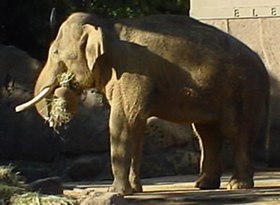Elephas
Elephas este unul din cele două genuri extante din familia Elephantidae, ordinul Proboscidea, având o singură specie supraviețuitoare, elefantul asiatic (Elephas maximus).[5]
Câteva specii dispărute au fost identificate ca făcând parte din gen, printre care Elephas recki, Elephas antiquus, Elephas falconeri și Elephas cypriotes. Genul Elephas este foarte apropiat de genul Mammuthus.[6]
Taxonomie[modificare | modificare sursă]
Elephas este clasificat ca făcând parte din ordinul Proboscidea, familia Elephantidae și conține o specie existenă în viață și 10 specii dispărute:[7]
- Elephas maximus;[5]
- Elephas beyeri †[9]
- Elephas celebensis †[10]
- Elephas ekorensis[7]
- Elephas falconeri †[11]
- Elephas hysudricus †[12]
- Elephas hysudrindicus †[13]
- Elephas iolensis †
- Elephas planifrons †
- Elephas platycephalus †
- Elephas recki †[14][15]
Note[modificare | modificare sursă]
- ^ Integrated Taxonomic Information System, , accesat în
- ^ Mammal Species of the World[*] Verificați valoarea
|titlelink=(ajutor); - ^ A Guide to the Mammals of China[*], p. 155 Verificați valoarea
|titlelink=(ajutor) - ^ Systema Naturae. 10th edition, Volume 1[*], p. 33 Verificați valoarea
|titlelink=(ajutor) - ^ a b Shoshani, J. (). „Genus Elephas”. În Wilson, D. E.; Reeder, D. M. Mammal Species of the World (ed. 3rd). Johns Hopkins University Press. p. 90. ISBN 978-0-8018-8221-0. OCLC 62265494.
- ^ Fleischer, R. C.; Perry, E. A.; Muralidharan, K.; Stevens, E. E.; Wemmer, C. M. (2001). Phylogeography of the Asian Elephant (Elephas maximus) based on mitochondrial DNA Arhivat în , la Wayback Machine.. Evolution 55(9): 1882–1892
- ^ a b Maglio, V.J. (1973). Origin and evolution of the Elephantidae. Transactions of the American Philosophical Society Philadelphia Volume 63. American Philosophical Society, Philadelphia. Pp. 149
- ^ Fernando, P., Vidya, T.N.C., Payne, J., Stuewe, M., Davison, G., et al. (2003). DNA Analysis Indicates That Asian Elephants Are Native to Borneo and Are Therefore a High Priority for Conservation. PLoS Biol 1 (1): e6
- ^ Von Königswald, G. H. R. (1956). Fossil mammals from the Philippines. National Research Council of the Philippines, Manila
- ^ Hooijer, D.A. (1949). Pleistocene Vertebrates from Celebes. IV. - Archidiskodon celebensis nov spec.. Zoologische Mededelingen Museum Leiden, 30 (14): 205–226.
- ^ Busk, G. (1867). Description of the remains of three extinct species of elephant, collected by Capt. Spratt, C.B.R.N., in the ossiferous cavern of Zebbug, in the island of Malta. Transactions of the Zoological Society of London, 6: 227–306.
- ^ Falconer, H. Cautley, P. T. (1846). Fauna Antiqua Sivalensis, Being the Fossil Zoology of the Sewalik Hills. Smith, Elder & Company, London. Pp. 64.
- ^ Hooijer, D. A. (1955). Fossil Proboscidea from the Malay Archipelago and the Punjab. Zoologische Verhandelingen, 28 (1): 1–146.
- ^ Todd, N. E. (2001). African Elephas recki: Time, space and taxonomy. In: Cavarretta, G., Gioia, P., Mussi, M. and M. R. Palombo. The World of Elephants, Proceedings of the 1st International Congress. Consiglio Nazionale delle Ricerche, Rome, pp. 693–697.
- ^ Todd, N. E. (2005). Reanalysis of African Elephas recki: Implications for time, space and taxonomy. Quaternary International Volumes 126–128: 65–72.


